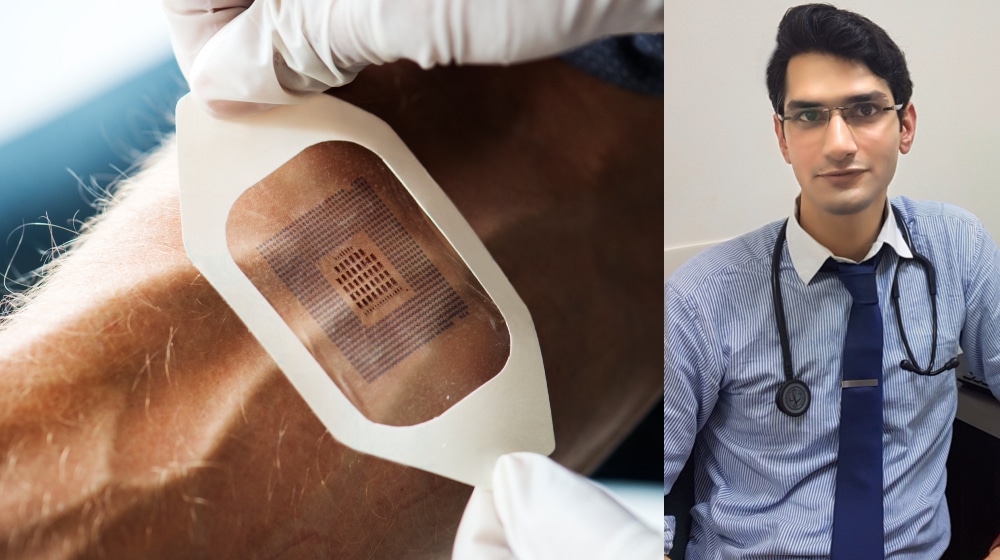Led by Dr. Talha Durrani from Peshawar’s Khyber Teaching Hospital (KTH), a team of doctors, engineers, and data scientists, has indigenously developed a painless insulin delivery device using transdermal patches.
If produced on a large scale, the device has the potential to replace the traditional injections/pens used to inject insulin into the body.
According to details, the prototype of the device has passed initial bench testing and is undergoing further pilot laboratory tests. The team has already filed for a patent and is also working closely with academics in England.
While the device is still in the testing phase, it has already gained interest from a few international investors.
As per a recent independent survey, diabetes is highly prevalent in Pakistan, with every 1 out of 5 suffering from the disease. Pain associated with daily insulin injection treatment leads to a lower quality of life and treatment non-compliance, especially for children afflicted with the ailment.
The Team
The team behind the innovation consists of Prof. Dennis Douroumis from England and Dr. Anam Abid, a Mechatronics Engineer who looked into more child-friendly and in-expensive solutions while Dr. Mian Ayaz ul Haq, a UK-based Consultant Neurologist, worked as a mentor with the team to provide oversight and guidance throughout the project.
Speaking exclusively with ProPakistani, Prof. Dennis, founder of Delta Pharmaceutics Ltd, said:
Our aim is to develop medical devices and dosage forms that are friendly to children and improve medication adherence.
Dr. Anam, Lecturer, Mechatronics Engineering, UET Peshawar, added:
Only a handful of patients in the country can afford the less-invasive treatments available in some advanced countries. Therefore, we have developed an effective treatment that will be within reach of an average person once mass-produced.
Dr. Talha, Resident Physician, Khyber Teaching Hospital Peshawar, said :
No one person can innovate on their own. It’s a team game and involves field specialists with vastly different experiences to solve a single problem. I hope our work encourages doctors, engineers, business administrators, and investors to come together at one table and explore ideas for such projects.
Project Details
While the team asked ProPakistani not to publicize the details of the working principle of its device because it is still under testing, Dr. Talha was kind enough to comprehensively answer a few questions for our readers:
What’s the difference in the absorption ratio of the patch and the injection/pen?
The standard insulin injection is subcutaneous, meaning it uses a needle to inject a drug into the tissue layer between the skin and the muscle while the patch is transdermal, meaning it delivers a drug through the skin.
Published literature on animals has shown that the absorption ratio tested on mice showed practically no difference in the absorption ratio of the patch and injection.
Although human testing is not yet conducted, considering if an injection roughly takes 1 second to deliver the drug and the human skin is around 4 times thicker than mice, the time to administer insulin through a patch would not exceed 2 seconds.
Patches have been used for years. What were the technical or medical difficulties that prevented the use of insulin patches until now?
Medical doctors often prescribe certain patch-based medications like Scopolamine (anti-nausea) and Fentanyl (analgesic). The problem with insulin is that it is a far more unstable drug than many medications. Hence, it needs to be delivered by piercing the skin.
Now, the size of the needle corresponds to the pain that it causes. A 10 cc syringe needle causes more pain than a 5 cc needle. 1 cc needle causes less pain than either of these and a syringe needle smaller than the one in a 1 cc syringe would cause the least amount of pain.
From a manufacturing point of view, the problem is that it is practically impossible to make an injection needle smaller than the one used in the 1 cc syringe. Hence, experts thought it might be a good idea to use solid microneedles, which are so small that they cannot be seen with the naked eye and cause practically no pain, in a patch. Such a patch works by spraying insulin on it but the problem is that the microneedles do not transfer more than two units per patch. We also imported such patches and tested them many times but they failed to work effectively.
The breakthrough came at the start of 2021 as modern machinery helped to produce hollow microneedles that do not break and do not pose manufacturing challenges, which have been used in the patch and work efficiently.
How cost-effective will these insulin patches be in comparison to the traditional insulin/injection setup?
It is tough to predict the price at the moment because we might still try more prototype iterations. Roughly speaking, the manufacturing of the patch’s applicator system costs Rs. 50 at this point, which is very similar to the traditionally used insulin/injection setup.
The team concluded that the production of such devices shows positive development in the academic landscape of Pakistan, calling all concerned stakeholders to collaborate to bring innovative projects from concept to reality.



























Wow, impressive!
great Job Dr Shib,
Very interesting and well written. Kudos